-
Countries
-
Data and Analysis
-
Special Focus
-
Crisis Responses

Contact
DTM DRC, iomdrcdtm@iom.int
Language
French
Location
Democratic Republic of the Congo
Period Covered
Dec 19 2023
Jan 27 2024
Activity
- Mobility Tracking
- Event Tracking
Depuis 2022, la région orientale de la République démocratique du Congo (RDC), en particulier le Nord-Kivu, est en proie à un conflit dévastateur qui s'est intensifié et est devenu de plus en plus complexe au fil du temps, avec le potentiel d'atteindre des niveaux sans précédent dans le Nord-Kivu. Cette crise se caractérise par une multitude d'acteurs armés en conflit, une importante population déplacée et une population encore plus importante en manque d'aide humanitaire. Le conflit actuel entre le groupe rebelle M23 et les Forces armées de la République démocratique du Congo (FARDC) et leurs alliés a été une source majeure de violence et d'instabilité dans la région. La situation s'est encore détériorée depuis le début du retrait de plusieurs bases des forces de la Communauté de l'Afrique de l'Est (CAE) des territoires affectés. Ce conflit a non seulement causé la perte de vies humaines et le déplacement de millions de personnes, mais il a également entravé les efforts visant à instaurer la paix et la stabilité dans la région.
Depuis le début de la crise, l'OIM, par le biais de la DTM continue à mener une série d'évaluations rapides, y compris le suivi des urgences (EET/ERM), l'analyse des crises et enregistrement avec priorité de répondre aux besoins immédiats d'information en vue de comprendre la dynamique des déplacements et les besoins. Ce rapport présente les résultats des évaluations menées dans les différentes zones de déplacement et de retour du 19 décembre 2023 au 27 janvier 2024.

Contact
RDH Asia and the Pacific Support - rdhroapsupport@iom.int
Language
English
Location
Afghanistan
Period Covered
Aug 15 2021
Aug 15 2023
Activity
- Flow Monitoring
From when the reporting period started to where it ends, (15 August 2021 to 15 August 2023), the gap between total outflows and inflows has dwindled between Afghanistan and two of its neighbouring countries, that is the Islamic Republic of Iran and Pakistan.
By the second half of the reporting period, cross-border movements reached close to a 1 to1 ratio between outflows (4,307,755) and inflows (4,314,442).
Changes in these flows across this two year period may be more generally attributed to the combination of tighter governmental controls on border crossings, temporary border closures, and fear of deportations of Afghan nationals living abroad. The following sections point to notable peaks and downturns in mobility flows to help put into perspective the timeline and context in which IOM operates in.
Contact
DTM Yemen, iomyemendtm@iom.int
Location
Yemen
Activity
- Mobility Tracking
- Event Tracking
Period Covered
Jan 28 2024 -Feb 03 2024
From 1 January to 3 February 2024, IOM Yemen DTM tracked 341 households (HH) (2,046 Individuals) who experienced displacement at least once.
Between 28 January and 3 February 2024, IOM Yemen DTM tracked 30 households (180 individuals) displaced at least once. The majority of people moved into/within the following governorates and districts:
- Ma’rib (20 HHs) – Harib (11 HHs), Marib City (7 HHs), Marib (2 HHs) districts. Most displacements in the governorate originated from Marib and Ta’iz.
- Al Hodeidah (8 HHs) – Hays (5 HHs), Al Khukhah (3 HHs) districts. Most displacements in the governorate were internal.
- Lahj (2 HHs) – Tuban (2 HHs) district. Most displacements in the governorate originated from Ta’iz and Al Hodeidah.
The majority of people moved from the following governorates and districts:
- Ma’rib (12 HHs) – Harib (12 HHs) district.
- Al Hodeidah (8 HHs) – Al Jarrahi (3 HHs), At Tuhayta (2 HHs), Al Hali (1 HH) districts.
- Ta’iz (4 HHs) – At Taiziyah (1 HH), Maqbanah (1 HH), Al Mawasit (1 HH) districts.
Population Groups
Survey Methodology
Unit of Analysis Or Observation
Type of Survey or Assessment
Keywords
Geographical Scope
Administrative boundaries with available data
The current dataset covers the following administrative boundaries
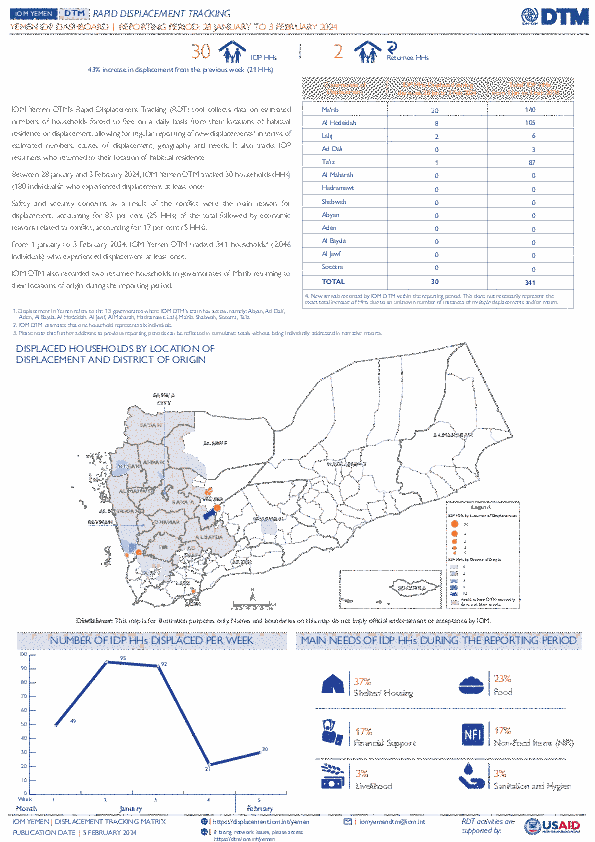
Contact
DTM Yemen, iomyemendtm@iom.int
Language
English
Location
Yemen
Period Covered
Jan 28 2024
Feb 03 2024
Activity
- Mobility Tracking
- Event Tracking
IOM Yemen DTM’s Rapid Displacement Tracking (RDT) tool collects data on estimated numbers of households forced to flee on a daily basis from their locations of origin or displacement, allowing for regular reporting of new displacements in terms of estimated numbers, geography, and needs. It also tracks returnees who returned to their location of origin.
|
From 1 January to 3 February 2024, IOM Yemen DTM tracked 341 households (HH) (2,046 Individuals) who experienced displacement at least once. Between 28 January and 3 February 2024, IOM Yemen DTM tracked 30 households (180 individuals) displaced at least once. The majority of people moved into/within the following governorates and districts: |
- Ma’rib (20 HHs) – Harib (11 HHs), Marib City (7 HHs), Marib (2 HHs) districts. Most displacements in the governorate originated from Marib and Ta’iz.
- Al Hodeidah (8 HHs) – Hays (5 HHs), Al Khukhah (3 HHs) districts. Most displacements in the governorate were internal.
- Lahj (2 HHs) – Tuban (2 HHs) district. Most displacements in the governorate originated from Ta’iz and Al Hodeidah.
The majority of people moved from the following governorates and districts:
- Ma’rib (12 HHs) – Harib (12 HHs) district.
- Al Hodeidah (8 HHs) – Al Jarrahi (3 HHs), At Tuhayta (2 HHs), Al Hali (1 HH) districts.
- Ta’iz (4 HHs) – At Taiziyah (1 HH), Maqbanah (1 HH), Al Mawasit (1 HH) districts.
IOM identified 56 households displaced in the previous reporting period, which covered 21 - 27 January 2024, in the governorates of Ta’iz (25 HHs), Ma’rib (21 HHs), Al Hodeidah (9 HHs), and Ad Dali (1 HH). These figures have been added to the cumulative displacement total recorded since the beginning of the year.
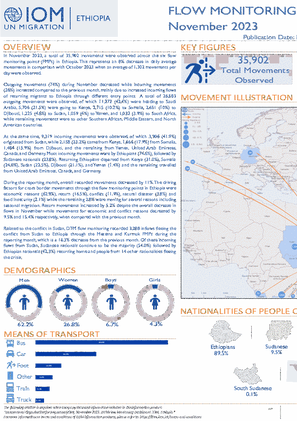
Contact
DTM Ethiopia, DTMEthiopia@iom.int
Language
English
Location
Ethiopia
Period Covered
Nov 01 2023
Nov 30 2023
Activity
- Flow Monitoring
In November 2023, a total of 35,902 movements were observed across the six flow monitoring points (FMPs) in Ethiopia. This represents an 8% decrease in daily average movements in comparison with October 2023 when an average of 1,302 movements per day were observed.
Outgoing movements (74%) during November decreased while incoming movements (26%) increased compared to the previous month, mainly due to increased incoming flows of returning migrants to Ethiopia through different entry points. A total of 26,583 outgoing movements were observed, of which 11,272 (42.4%) were heading to Saudi Arabia, 5,706 (21.5%) were going to Kenya, 2,715 (10.2%) to Somalia, 2,651 (10%) to Djibouti, 1,225 (4.6%) to Sudan, 1,059 (4%) to Yemen, and 1,032 (3.9%) to South Africa, while remaining movements were to other Southern African, Middle Eastern, and North American countries.
At the same time, 9,319 incoming movements were observed, of which 3,906 (41.9%) originated from Sudan, while 2,158 (23.2%) came from Kenya, 1,666 (17.9%) from Somalia, 1,484 (15.9%) from Djibouti, and the remaining from Yemen, United Arab Emirates, Canada, and Germany. Most incoming movements were by Ethiopians (74.6%), followed by Sudanese nationals (23.8%). Returning Ethiopians departed from Kenya (31.0%), Somalia (24.0%), Sudan (22.5%), Djibouti (21.1%), and Yemen (1.4%) and the remaining travelled from United Arab Emirates, Canada, and Germany.
Contact
DTM Yemen, iomyemendtm@iom.int
Location
Yemen
Activity
- Mobility Tracking
- Event Tracking
Period Covered
Jan 21 2024 -Jan 27 2024
From 1 to 27 January 2024, IOM Yemen DTM tracked 255 households (HH) (1,530 Individuals) who experienced displacement at least once.
Between 21 and 27 January 2024, IOM Yemen DTM tracked 21 households (126 individuals) displaced at least once. The majority of people moved into/within the following governorates and districts. The majority of people moved into/within the following governorates and districts:
- Al Hodeidah (13 HHs) – Hays (11 HHs), Al Khukhah (2 HHs) districts. All displacements in the governorate were internal.
- Ma’rib (7 HHs) – Ma’rib City (6 HHs), Ma’rib (1 HH) districts. Most displacements in the governorate originated from Amran and Ta’iz.
- Ad Dali (1 HH) – Ad Dali (1 HH) district. All displacements in the governorate originated from Sanaa.
The majority of people moved from the following governorates and districts:
- Al Hodeidah Ta’iz (13 HHs) – Hays (7 HHs), Al Hali (2 HHs), Jabal Ras (2 HHs) districts.
- Ta’iz (2 HHs) – At Taiziyah (1 HH), As Silw (1 HH) districts.
- Ibb (2 HHs) – Ar Radmah (1 HH), Al Qafr (1 HH) districts.
Population Groups
Survey Methodology
Unit of Analysis Or Observation
Type of Survey or Assessment
Keywords
Geographical Scope
Administrative boundaries with available data
The current dataset covers the following administrative boundaries
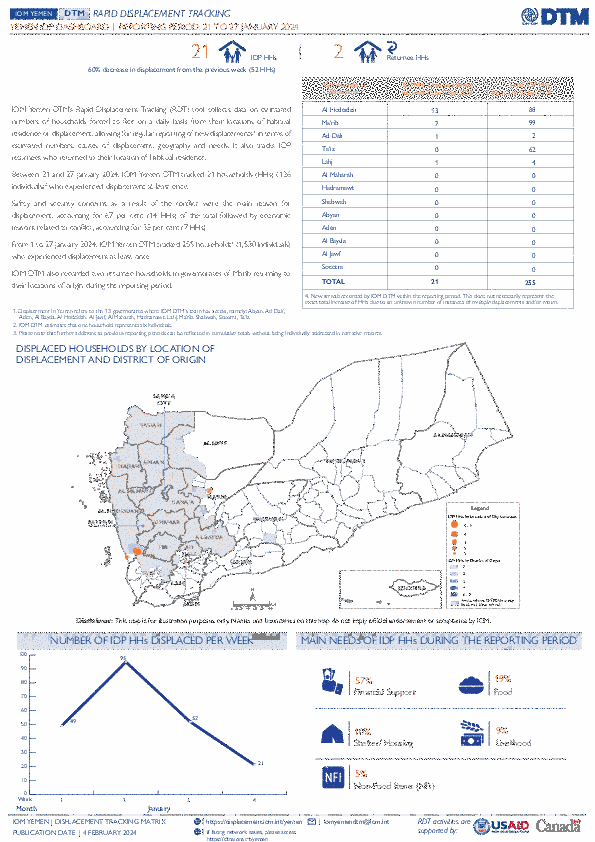
Contact
DTM Yemen, iomyemendtm@iom.int
Language
English
Location
Yemen
Period Covered
Jan 21 2024
Jan 27 2024
Activity
- Mobility Tracking
- Event Tracking
IOM Yemen DTM’s Rapid Displacement Tracking (RDT) tool collects data on estimated numbers of households forced to flee on a daily basis from their locations of origin or displacement, allowing for regular reporting of new displacements in terms of estimated numbers, geography, and needs. It also tracks returnees who returned to their location of origin.
From 1 to 27 January 2024, IOM Yemen DTM tracked 255 households (HH) (1,530 Individuals) who experienced displacement at least once.
Between 21 and 27 January 2024, IOM Yemen DTM tracked 21 households (126 individuals) displaced at least once. The majority of people moved into/within the following governorates and districts. The majority of people moved into/within the following governorates and districts:
- Al Hodeidah (13 HHs) – Hays (11 HHs), Al Khukhah (2 HHs) districts. All displacements in the governorate were internal.
- Ma’rib (7 HHs) – Ma’rib City (6 HHs), Ma’rib (1 HH) districts. Most displacements in the governorate originated from Amran and Ta’iz.
- Ad Dali (1 HH) – Ad Dali (1 HH) district. All displacements in the governorate originated from Sanaa.
The majority of people moved from the following governorates and districts:
- Al Hodeidah (13 HHs) – Hays (7 HHs), Al Hali (2 HHs), Jabal Ras (2 HHs) districts.
- Ta’iz (2 HHs) – At Taiziyah (1 HH), As Silw (1 HH) districts.
- Ibb (2 HHs) – Ar Radmah (1 HH), Al Qafr (1 HH) districts.
IOM identified 40 households displaced in the previous reporting period, which covered 14 - 20 January 2024, in the governorates of Al Hodeidah (26 HHs), Ma’rib (8 HHs), Ta’iz (6 HHs). These figures have been added to the cumulative displacement total recorded since the beginning of the year.
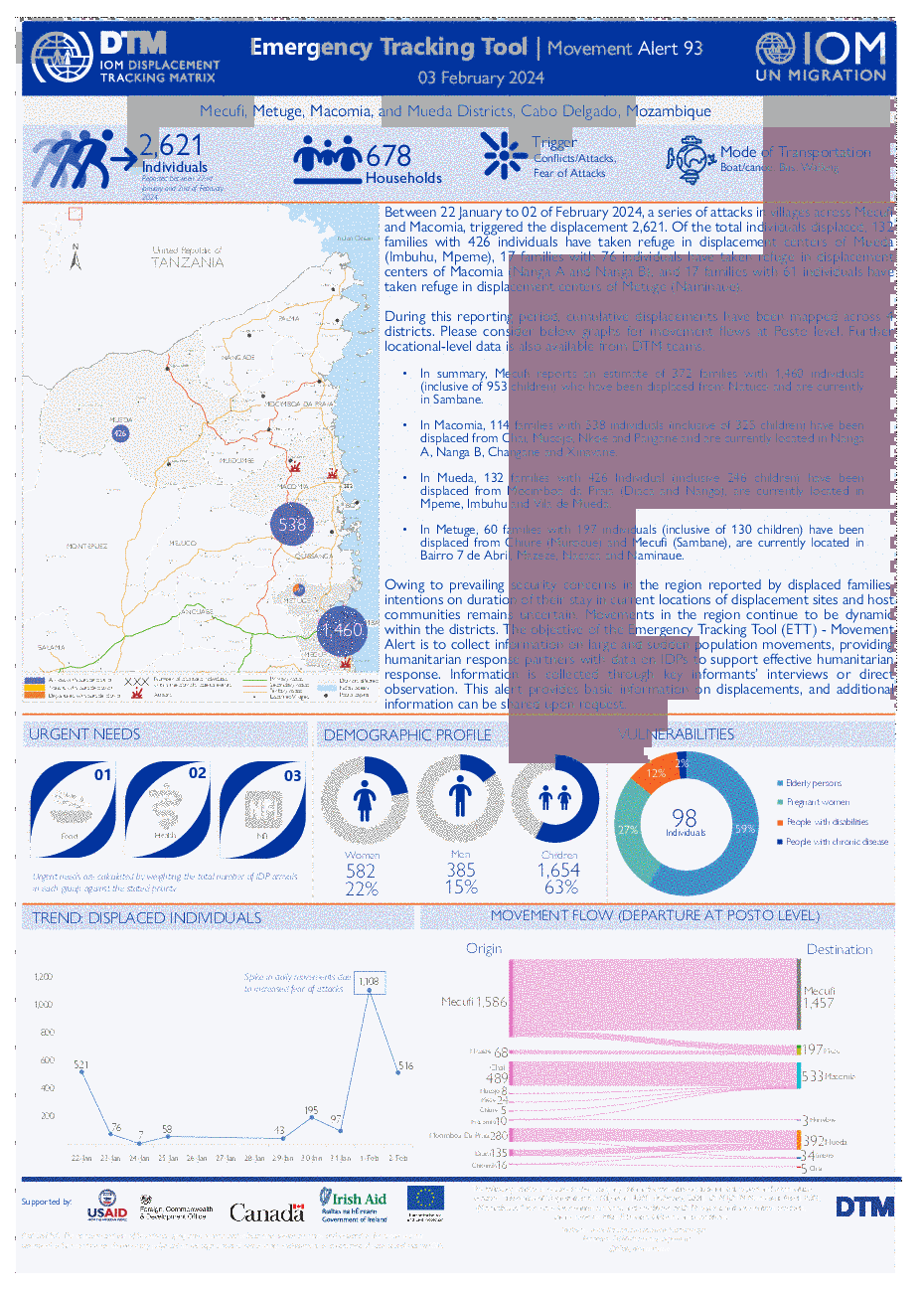
Contact
DTMMozambique@iom.int
Language
English
Location
Mozambique
Period Covered
Jan 22 2024
Feb 02 2024
Activity
- Mobility Tracking
- Event Tracking
Between 22 January to 02 of February 2024, a series of attacks in villages across Mecufi and Macomia, triggered the displacement 2,621. Of the total individuals displaced, 132 families with 426 individuals have taken refuge in displacement centres of Mueda (Imbuhu, Mpeme), 17 families with 76 individuals have taken refuge in displacement centres of Macomia (Nanga A and Nanga B), and 17 families with 61 individuals have taken refuge in displacement centres of Metuge (Naminaue).
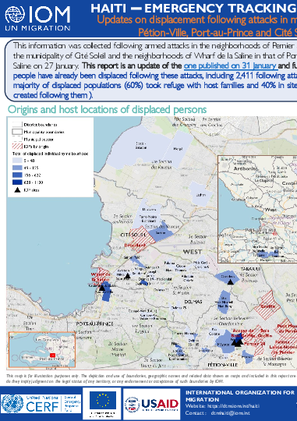
Contact
dtmhaiti@iom.int
Language
English
Location
Haiti
Period Covered
Jan 27 2024
Feb 02 2024
Activity
- Mobility Tracking
- Event Tracking
This information was collected following armed attacks in the neighborhoods of Pernier and its surroundings in the municipality of Pétion Ville, in the neighborhoods of Drouillard in the municipality of Cité Soleil and the neighborhoods of Wharf de la Saline in that of Port- au-Prince. Attacks in Pernier and Drouillard began on 30 January 2024 and at Wharf de la Saline on 27 January. This report is an update of the one published on 31 January and further updates will be published according to the evolution of displacement. A total of 4,327 people have already been displaced following these attacks, including 2,411 following attacks in Pernier, 1,239 following those at Wharf de la Saline as well as 677 in Drouillard. The majority of displaced populations (60%) took refuge with host families and 40% in sites (1,731 people in 6 sites including 4 existing sites before these incidents and 2 new sites created following them ).

Contact
DTM Europe, ROViennaDataResearch-Newsletter@iom.int
Language
English
Location
Republic of Moldova
Period Covered
Feb 01 2023
Jun 30 2023
Activity
- Survey
- Return Intention
The onset of the war in Ukraine has caused substantial displacement of people both within the Republic of Moldova’s borders and throughout the neighbouring region. The refugee situation is coupled with significant movement flows of Moldovan labour migrants returning from abroad, in particular from Ukraine, the Russian Federation, and other neighbouring countries. The effects of the Ukraine crisis, combined with the lingering consequences of the COVID-19 pandemic could potentially change the Republic of Moldova’s migration dynamics, leading to a decrease in emigration and an increase in the number of Moldovan citizens returning home.
This may have severe long term effects on the already strained Moldovan economy hindering its capacity to respond to the humanitarian and economic challenges attendant to the Ukrainian crisis. There are major gaps in data on Moldovan returnees, including information on their socio-economic profiles, needs and vulnerabilities as well as their intentions for their future. To fill those gaps the International Organization for Migration (IOM), as the leading inter-governmental organization promoting humane and orderly migration, has conducted a survey with Moldovan returnees in order to assess how the war in Ukraine has affected them.